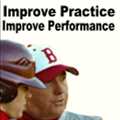Two Batting Cage Myths that are simply not true are (1) A Batting Cage must be long for it to be usable for all ages and
(2) A batter must see 75 miles per hour pitches to receive maximum benefit from cage work. Coach Dixon discusses how many
batting cage buyers are mistaken or misled in buying or building a new baseball batting cage. Two Batting Cage Myths that
are simply not true:
1. Batting Cage Myth Number One - A Batting Cage must be long for it to be usable for all ages.
This is simply not true. Players of all ages, even the high school and collegiate levels can benefit from batting practice
in batting cages that are 35 to 50 feet in length. A batting cage does not have to be 70 feet long for it to beneficial to
advanced players. The reason for this is that long-toss, front-toss and various other batting practice drills can be performed
at distances under the regular pitching distances. When batters take swings at pitches thrown at 35 feet, the batter is seeing
and reacting to pitches that simulate higher speeds at the normal pitching distance. The player must perform the swing with
the proper trigger, separate, and load actions. All of these elements of the swing must be done at the same speed, rhythm,
and timing as under normal game hitting.
2. Batting Cage Myth Number Two - A batter must see 75 miles per hour pitches to receive maximum benefit from batting cage
batting practice.
Most hitters at all levels of play including high school, college, and pros would rather see and hit live arm pitches at
45 miles per hour at 30 feet than pitches thrown by a machine at 75 miles per hour. Live-arm batting practice is batting practice
thrown by a person not a machine. We must remember that advanced batters benefit most from seeing pitches thrown by a person.
The batter must pick-up the pitcher arm-slot, the pitcher release point and time the speed of the pitch thrown. When a person
is throwing batting practice the speed and location of every pitch can be changed. It is also a fact that many people are
not adept at throwing strikes at longer distances. However, most people can throw an accurate pitch for a strike from 30and
40 feet distances. The batter gets more work in because more pitches are hittable. Not as much time and effort is wasted by
with bad pitches out of the strike zone. The shorter distance makes the workout more efficient.
What does this all mean to you as a batting cage buyer?
You do not have to buy a 70 feet long cage with an expensive pitching machine to get incredible benefits from owning a
batting cage. The 70 foot long batting cage is great for team or institutions because it can be divided into two 35 feet mini
batting cages that allow two batters to work at a time. So there is a benefit to owning a longer cage if you are buying it
for a school or team use. But, for the average home user, a 45 to 55 feet cage is suitable for all drills, batting practice,
and applications that you will need for your player to be successful through the high school level. In my opinion, many people
become discouraged from buying a batting cage because they feel they must buy a 70 feet cage with a $2000 pitching machine.
They feel they must spend $3000 to $5000. This is not true. You can get all the practice they need by buying a batting cage
and frame with an investment under $800. If at some time later you decide to purchase a machine, you can always do so. I think
it is important to realize that the batting cage you buy will be used for a variety of batting drills. The function of the
batting cage is safety, ball containment, and practice efficiency. The batting cage is no better than the parent or coach
that dedicates time for its use. If you use it, you will experience incredible results. It will be a wise investment. Kids
can not use the batting cage without parental or adult supervision and participation. If you do not have the time to spend
with your player in the cage, you would be better advised to buy a self-contained solo-practice device such as the BatAction
Seft-Trainer Hitting Machine.
Nick Dixon is the President and founder of
Nedco Sports, the "Hit2win Company". Dixon is also an active and full time high school baseball coach with over 25 years experience.
Dixon is widely recognized as an expert in the area of baseball training, practice and skill development. Coach Dixon is better
known as the inventor of several of baseball and softball's most popular training products such as the Original BatAction
Hitting Machine, SKLZ Derek Jeter Hurricane Hitting Machine, Original Hitting Stick, Hit2win Trainer, SKLZ Target Trainer,
SKLZ Derek Jeter ZipnHit Pro, and Strikeback Trainer.
Dixon is also a contributing writer for BaseballCoachingDigest.com,
the Baseball 2Day Coaches Journal (bb2day.com), BattingCageBuilder.com, AmericanBaseballDirectory.com and the Hit2win Baseball Coaches Monthly Newsletter. Dixon has 5 blogs related to baseball training including the BaseballCoachingDigest Blog, CoachesBest Training Equipment Blog, Hurricane Machine Training Blog, Baseball Batting Cage Blog, and the Bat Action Training Blog.
Article Source: http://EzineArticles.com/?expert=Nick_Dixon

